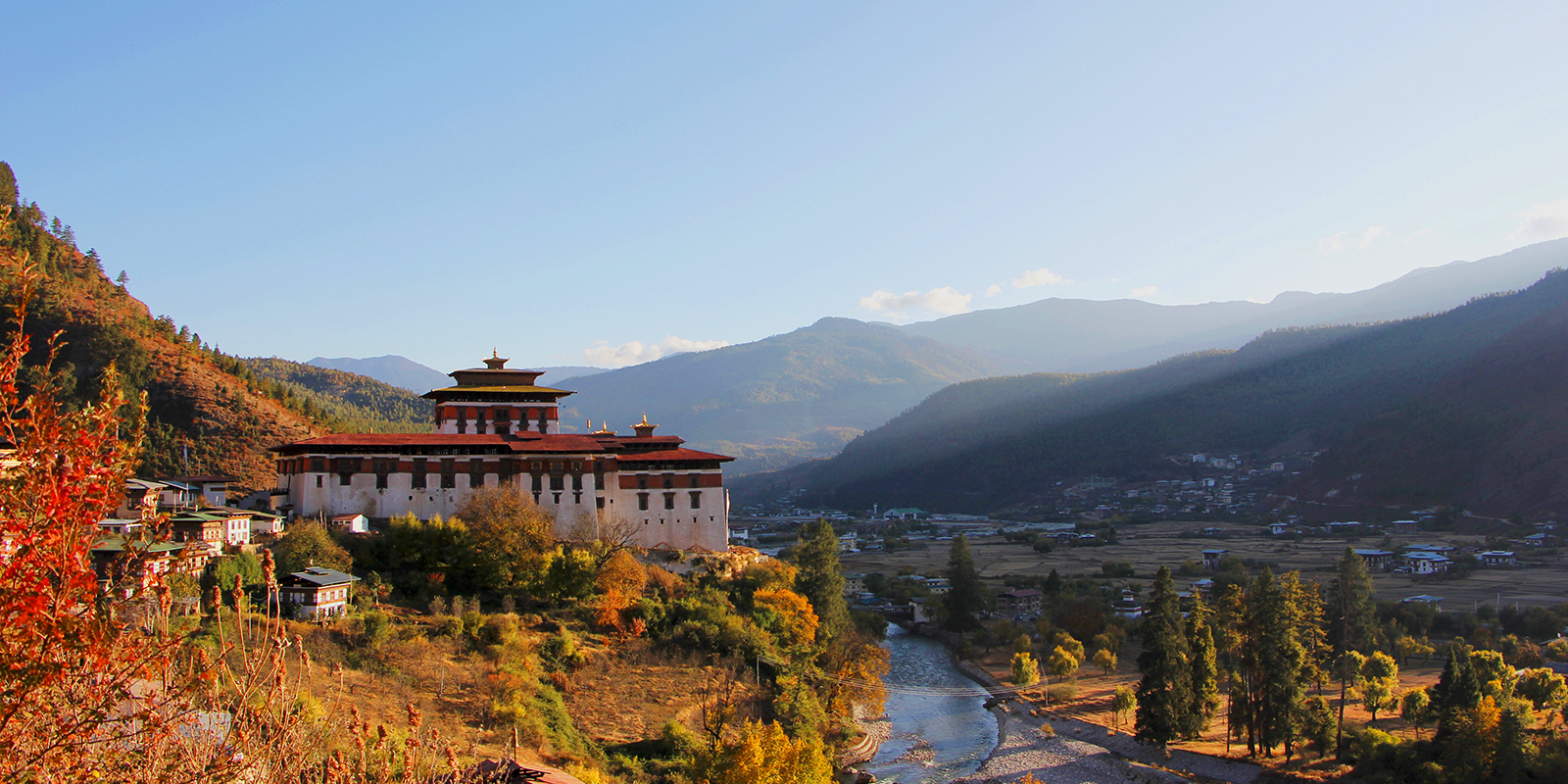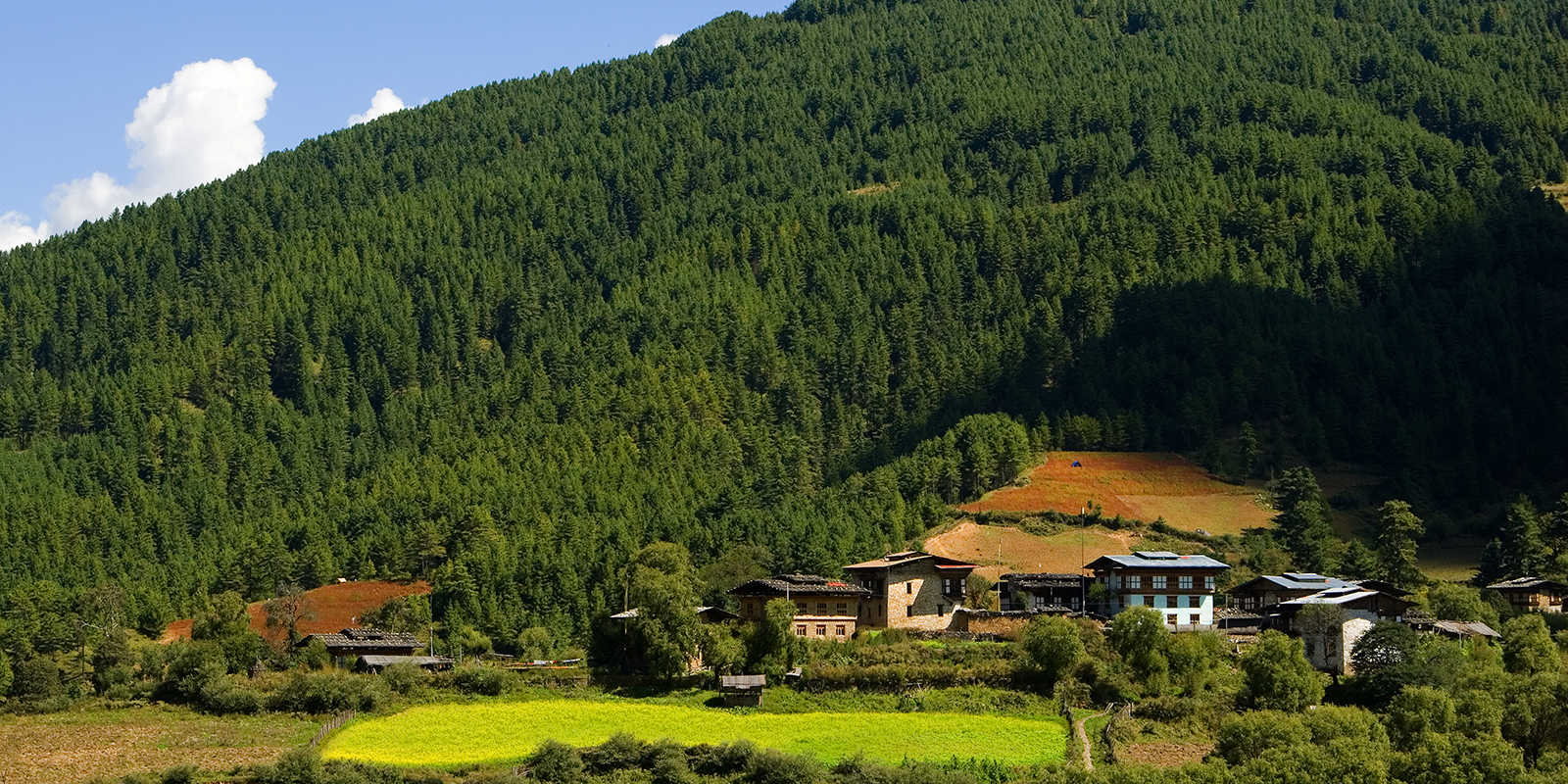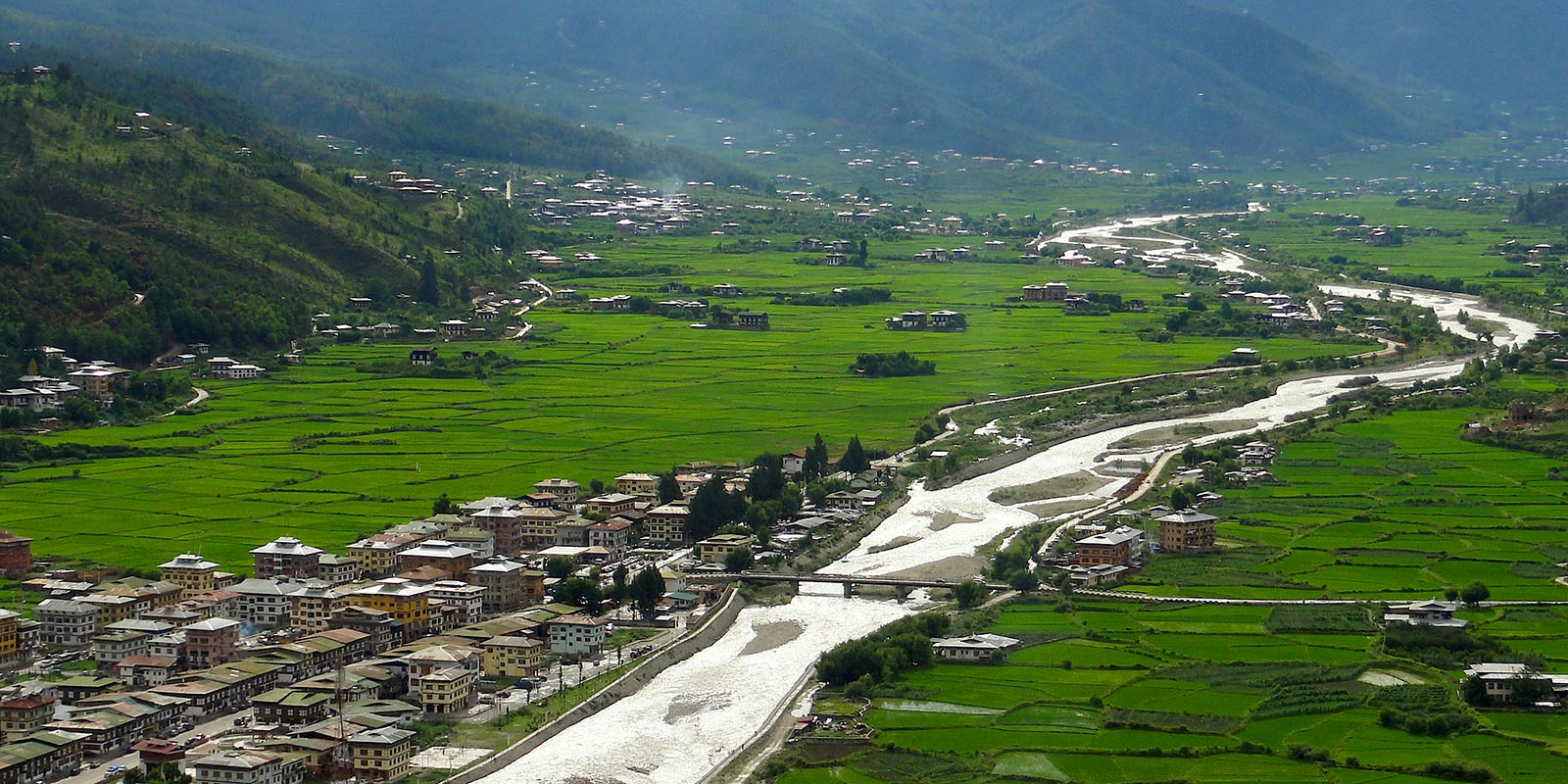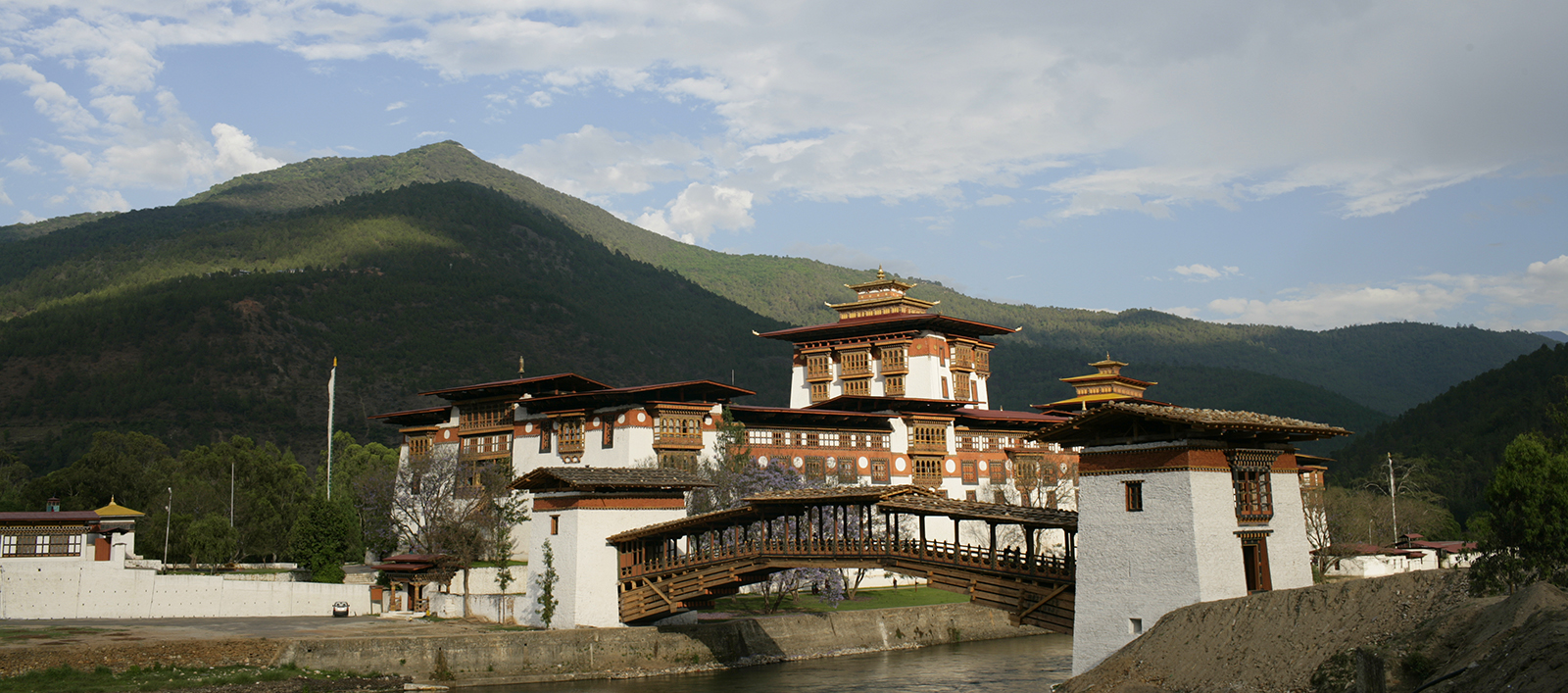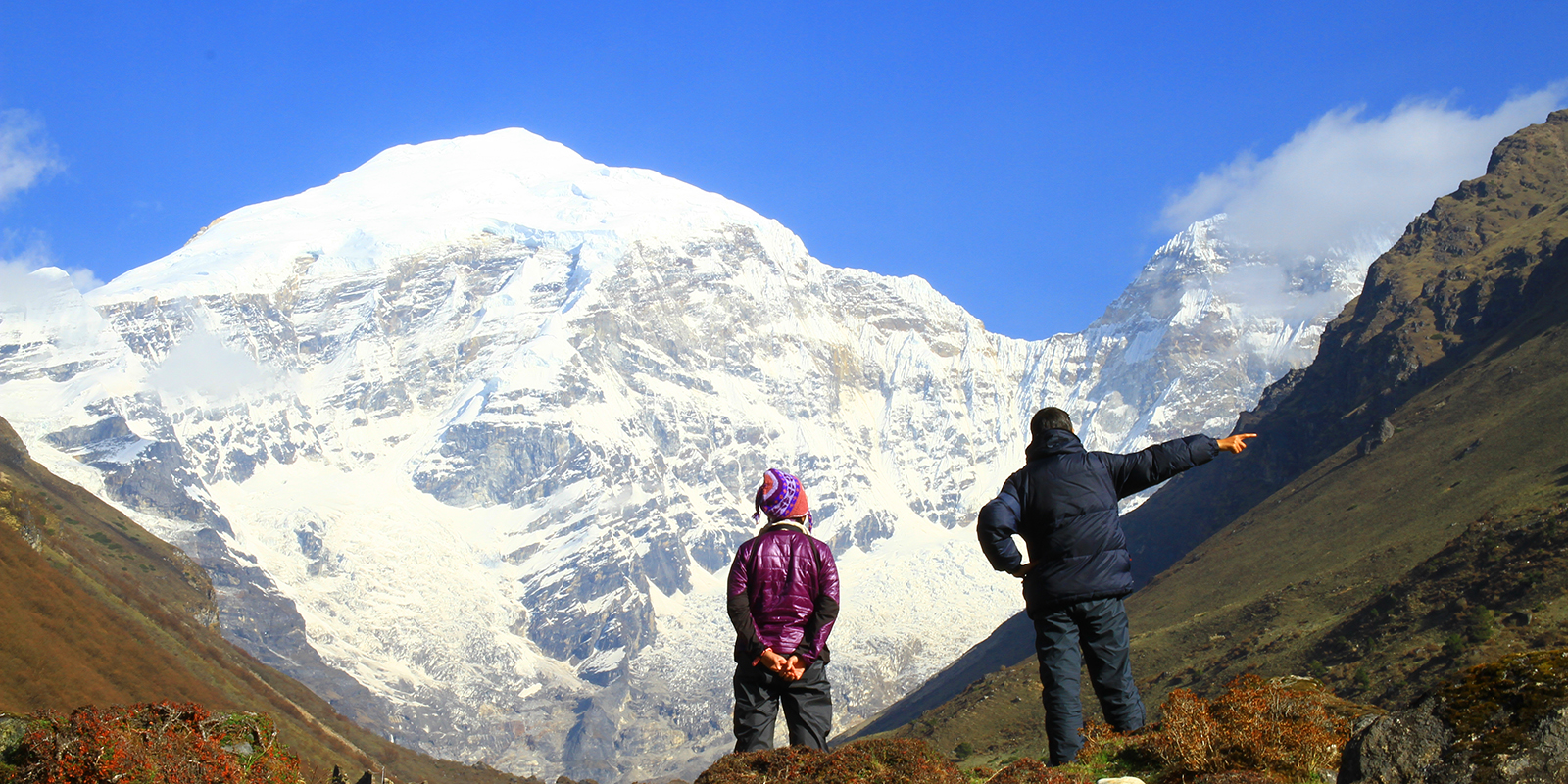
DAY 01: BAGDOGRA/SILIGURI – PHUENTSHOLING
Our representative will meet you on arrival at either Siliguri or Bagdogra airport in the Indian state of West Bengal . After a drive of about three hours along a road lined with lush green tea gardens you will reach Phuentsholing, the gateway to Bhutan , which lies directly at the base of the Himalayan foothills. This rapidly growing town is Bhutan ’s commercial center, with most commercial organizations headquartered here.
Dinner and overnight at the hotel in Phuentsholing. .
DAY 02: PHUENTSHOLING – THIMPHU
After breakfast, proceed to Thimphu , making our first stop about 5 km. up the road to visit Kharbandi Gompa. This beautiful monastery situated in a garden of tropical plants and flowers, was built by Royal Grandmother, Ashi Phuntsho Choedron in 1967. There is a splendid view of Phuentsholing and the Indian plains from the monastery garden.
From this point the road climbs steeply up into the hills, winding in innumerable bends, to an altitude of approximately 2,000m/6,560ft. We will make stops along the way from time to time, so as not to miss the magnificent view of the Indian plains and the Toorsa river below. After a two hour drive through light mountain jungle, displaying lianas and orchids, we pass over the first ridge and begin a long and gradual descent to the river which is the source of energy for the massive Chukha Hydel hydroelectric power project. We cross the river, and rise up the mountainside ever further into the hills, leaving Chukha and the small town of Chimakothi behind us. Lunch is served en route.
After passing through Chapcha the road reaches its highest point of about 2,800m/9,185ft, then descends steeply and runs along the banks of the Wang Chu (river) to Chuzom (meaning confluence), where the Paro Chu runs into the Wang Chu. From here it is only about 2 hours’ drive up the valley to Thimphu . Shortly before reaching our destination, we will stop to visit Simtokha Dzong, the oldest fortress in the kingdom, built by Shabdrung Ngawang Namgyal in 1627.
On arrival in Thimphu , check into the hotel. Dinner and overnight at the hotel in Thimphu .
DAY 03: THIMPHU
Once a rustic village sitting in a broad, fertile river valley, Thimphu is today the nation’s bustling capital. Today’s full day of sightseeing in Thimphu includes visits to: * Tashichhodzong, “the fortress of the glorious religion”: Initially erected in 1641 by Shabdrung Ngawang Namgyal, it was rebuilt in the 1960s during the reign of Bhutan ’s third king in the traditional style, without plans or nails. Tashichhodzong houses some ministries, His Majesty’s secretariat, and the central monk body; * National Memorial Chorten: The building of this landmark was envisaged by Bhutan ’s third king, His Majesty Jigme Dorji Wangchuck, as a monument to world peace and prosperity. Completed in 1974 after his untimely death, it is both a memorial to the Late King (”the father of modern Bhutan”) and a monument to world peace; * Institute for Zorig Chusum (commonly known as the Painting School) where students undertake a six-year course on the 13 traditional arts and crafts of Bhutan; * National Library, which holds an extensive collection of Buddhist texts and manuscripts, some dating back several hundred years, as well as modern academic books, mainly on Himalayan culture and religion.
Other places of interest which may be visited if time permits include: the National Institute of Traditional Medicine (outside only), where medicinal herbs are compounded and dispensed, and traditional medical practitioners trained; the Handicrafts Emporium, which displays a wide assortment of beautifully hand-woven textiles and craft products, and also a small collection of books on Bhutan, Buddhism and Himalayan culture; the Folk Heritage and National Textile Museums.
In the evening take a stroll through Thimphu ’s market area, visiting local shops and mingling with the people. Overnight at the hotel in Thimphu .
DAY 04: THIMPHU – PUNAKHA – WANGDUEPHODRANG
After breakfast proceed to Punakha, stopping briefly about 45 minutes’ drive from Thimphu at Dochu-la pass (3,088m/10,130ft), which offers visitors their first glimpse of the eastern Himalayan ranges.
A low-lying subtropical valley, Punakha served as the capital of Bhutan until 1955, and is still the winter residence of the Je Khenpo (Chief Abbot) and central monk body. Punakha Dzong, built in 1637 by Shabdrung Ngawang Namgyal, has played prominent role in civil and religious life of the kingdom. Damaged by fire, flood and earthquake over the centuries, it has now been fully restored in its original splendor.
Also visit the valley of Wangduephodrang situated at the junction of the Punakha Chu and Tang Chu rivers. Overnight at the hotel in Punakha/Wangduephodrang.
DAY 05: PUNAKHA – WANGDUEPHODRANG – PARO
Morning sightseeing in Wangduephodrang, a typical small Bhutanese town, with bustling market and well-stocked shops. This area is also known for its fine bamboo work, stone carvings, locally mined slate, and a yak dairy research station.
Wangduephodrang Dzong is the town’s most visible feature, situated majestically on a spur above the junction of the Punakha Chu and Tang Chu rivers.
After lunch, we drive to Paro, visiting a village house en route to get an idea of the lifestyle of the local people. Overnight at the hotel in Paro.
DAY 06: PARO
This beautiful valley is home to some of Bhutan ’s oldest temples and monasteries, the National Museum and the country’s only airport.
Situated strategically and commanding a spectacular view of the valley, Rinpung Dzong (”the fortress of the heap of jewels”) was built by Shabdrung Ngawang Namgyal in 1646, and now houses Paro’s monk body and the offices of the civil administration. It is also the venue for the annual springtime Paro Tsechu (festival). Above Rinpung Dzong (commonly referred to as Paro Dzong) is Ta Dzong, housing the National Museum , which holds unique and varied collections ranging from ancient armor, to textiles, thangkha paintings, stamps, coins and natural history.
A short drive north and overlooking the Paro river is Kyichu Lhakhang, one of the oldest and most sacred shrines of Bhutan, dating back to the 7th century, when Buddhism was first introduced into Bhutan. Further ahead, at the end of valley lies Drukgyel Dzong, or “the Fort of Drukpa Victory”, built in 1646 by Shabdrung Ngawang Namgyal to commemorate his victory over the Tibetan invaders.
Evening at leisure to visit local shops. Overnight at the hotel in Paro.
DAY 07: DEPART PARO
After early breakfast in the hotel, drive to the airport for flight to onward destination.
